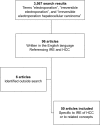Irreversible electroporation of hepatocellular carcinoma: patient selection and perspectives
- PMID: 28331845
- PMCID: PMC5357069
- DOI: 10.2147/JHC.S129063
Irreversible electroporation of hepatocellular carcinoma: patient selection and perspectives
Abstract
Irreversible electroporation (IRE) is a novel form of tissue ablation that uses high-current electrical pulses to induce pore formation of the cell lipid bilayer, leading to cell death. The safety of IRE for ablation of hepatocellular carcinoma (HCC) has been established. Outcome data for ablation of HCC by IRE are limited, but early results are encouraging and suggest equivalency to the outcomes obtained for thermal ablation for appropriately selected, small (<3 cm) tumors. Long-term oncologic efficacy and histopathologic response data have not been published, and therefore, application of IRE for the treatment of HCC should still be viewed with caution.
Keywords: IRE; ablation; hepatic; liver; tumors.
Conflict of interest statement
Disclosure The authors report no conflicts of interest in this work.
Figures


Similar articles
-
Irreversible electroporation of hepatocellular carcinoma: the role of ultrasonography.Ultrasonography. 2020 Jul;39(3):229-237. doi: 10.14366/usg.20023. Epub 2020 Apr 2. Ultrasonography. 2020. PMID: 32450674 Free PMC article.
-
Irreversible electroporation for the ablation of liver tumors: are we there yet?Arch Surg. 2012 Nov;147(11):1053-61. doi: 10.1001/2013.jamasurg.100. Arch Surg. 2012. PMID: 23165618 Review.
-
Cancer cells ablation with irreversible electroporation.Technol Cancer Res Treat. 2005 Dec;4(6):699-705. doi: 10.1177/153303460500400615. Technol Cancer Res Treat. 2005. PMID: 16292891
-
Evaluation of tolerability and efficacy of irreversible electroporation (IRE) in treatment of Child-Pugh B (7/8) hepatocellular carcinoma (HCC).HPB (Oxford). 2016 Jul;18(7):593-9. doi: 10.1016/j.hpb.2016.03.609. Epub 2016 May 1. HPB (Oxford). 2016. PMID: 27346140 Free PMC article.
-
Irreversible Electroporation for Colorectal Liver Metastases.Tech Vasc Interv Radiol. 2015 Sep;18(3):159-69. doi: 10.1053/j.tvir.2015.06.007. Epub 2015 Jun 18. Tech Vasc Interv Radiol. 2015. PMID: 26365546 Review.
Cited by
-
Emerging curative-intent minimally-invasive therapies for hepatocellular carcinoma.World J Hepatol. 2022 May 27;14(5):885-895. doi: 10.4254/wjh.v14.i5.885. World J Hepatol. 2022. PMID: 35721283 Free PMC article. Review.
-
Intraprocedural Transcatheter Intraarterial Perfusion (TRIP)-MRI for Evaluation of Irreversible Electroporation Therapy Response in a Rabbit Liver Tumor Model.Clin Exp Gastroenterol. 2020 Nov 6;13:543-553. doi: 10.2147/CEG.S269163. eCollection 2020. Clin Exp Gastroenterol. 2020. PMID: 33192084 Free PMC article.
-
Effects of Interphase and Interpulse Delays on Tissue Impedance and Pulsed Field Ablation.Ann Biomed Eng. 2025 Aug;53(8):1962-1974. doi: 10.1007/s10439-025-03757-4. Epub 2025 May 16. Ann Biomed Eng. 2025. PMID: 40380020 Free PMC article.
-
Image-Guided Percutaneous Ablation for Primary and Metastatic Tumors.Diagnostics (Basel). 2022 May 24;12(6):1300. doi: 10.3390/diagnostics12061300. Diagnostics (Basel). 2022. PMID: 35741109 Free PMC article. Review.
-
Generic surgical process model for minimally invasive liver treatment methods.Sci Rep. 2022 Oct 6;12(1):16684. doi: 10.1038/s41598-022-19891-1. Sci Rep. 2022. PMID: 36202857 Free PMC article.
References
-
- Stewart BW, Wild CP, editors. World Cancer Report 2014. [Accessed October 1, 2016]. Available from: http://publications.iarc.fr/Non-Series-Publications/World-Cancer-Reports....
-
- Pompili M, Mirante VG, Rondinara G, et al. Percutaneous ablation procedures in cirrhotic patients with hepatocellular carcinoma submitted to liver transplantation: assessment of efficacy at explant analysis and of safety for tumor recurrence. Liver Transpl. 2005;11(9):1117–1126. - PubMed
-
- Carey RI, Leveillee RJ. First prize: direct real-time temperature monitoring for laparoscopic and CT-guided radiofrequency ablation of renal tumors between 3 and 5 cm. J Endourol. 2007;21(8):807–813. - PubMed
Publication types
LinkOut - more resources
Full Text Sources
Other Literature Sources

